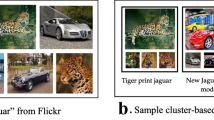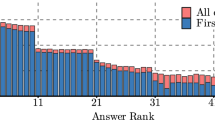Abstract
Today’s web search engines return very large result sets for query formulations consisting of few specific keywords. Results are presented as ranked lists containing textual description of found items. Such representations do not allow identification of topical clusters, and consequentially make it difficult for users to refine queries efficiently. In this paper, we present WebRat, a framework for web-based retrieval, clustering and visualisation which enables parallel querying of multiple search engines, merging of retrieved result sets, automatic identification of topical clusters and interactive visualisation of the result sets and clusters for query refinement. This framework is lightweight in the sense that it consists of a small, platform-independent component which can be easily integrated into exisiting Internet or Intranet search forms without requiring specific system environments, server resources or precalculation efforts.
The WebRat system extends existing approaches to web search result visualisation in many aspects: Found results are added incrementally as they arrive, labelling is performed in 2-dimensional space on clusters the user can see and rendering is optimised to provide sufficient performance on standard office machines.
The WebRat framework has been used to implement a variety of applications: We have provided enhanced web search capabilities for users doing scientific research. Overview and refinement capabilities have been implemented for the environmental domain. Finally, abstracts generated on the fly by a knowledge management system have been used to provide topical navigation capabilities to developers searching for technical information in mailing list archives.
Preview
Unable to display preview. Download preview PDF.
Similar content being viewed by others
References
Andrews K., Gütl C., Moser J., Sabol V., Lackner W.: Search Result Visualisation with xFIND In Proceedings of UIDIS 2001, Zurich, Switzerland, May 2001. pp. 50–58
Boerner K., Chen C., Boyack K.W. (2003): Visualizing Knowledge Domains Annual Review of Information Science and Technology 37.
Cavnar, W.B., Trenkle, J. M. (1994): n-Gram based text categorization. In Symposion on Document Analysis and Information Retrieval, p161–176, University of Nevada, Las Vegas.
Chalmers M. (1993): Using a landscape methaphor to represent a corpus of documents. In Proceedings European Conference on Spatial Information Theory, COSIT 93, pages 337–390, Elba, September 1993.
Kohonen, T., Kaski, S., Lagus, K., Salojärvi, J., Honkela, J., Paatero, V., Saarela, A. (1999): Self organization of a massive text document collection. In Oja, E. and Kaski, S., editors, Kohonen Maps pages 171–182, Elsevier, Amsterdam, 1999
Leuski, A., Allan, J. (2000): Lighthouse: Showing theWay to Relevant Information. In the Proceedings of IEEE Symposium on Information Visualization 2000 (Info-Vis2000), Salt Lake City, Utah, October 2000. pp. 125–130.
Porter T., Du. T. (1984): Compositing Digital Images in SIGGRAPH 84, p253–259.
Reiter H., Muβler G., Mann T., Handschuh S.: Insyder — An Information Assistant for Business Intelligence In Proceedings of the 23rd Annual International ACM SIGIR Conference on Research and Developement in Information Retrieval, July 14–18, 2000Athens, Greece
Sabol V. (2001): Visualisation Islands: Interactive Visualisation and Clustering of Search Result Sets. Master’s Thesis at IICM, Graz University of Technology
Salton B., Buckley G. Term Weighting Approaches in Automatic Text Retrieval. Information Processing and Management, 24(5), pp. 513–523, 1988
Thomas, J., et al. (2001): Visual Text analysis-SPIRE Technical flier from the Pacific Northwest National Laboratory. http://www.pnl.gov/infoviz/spire.pdf
Tochtermann, K., Sabol, V., Kienreich, W., Granitzer, M. and Becker, J. (2002): Intelligent Maps and Information Landscapes: Two new Approaches to support Search and Retrieval of Environmental Information Objects. In Proceedings of 16th International Conference on Informatics for Environmental Protection, Vienna University of Technology, September 2002
Wise, J., Thomas, J., Pennock, K., Lantrip, D., Pottier, M., Schur, A. (1995): Visualizing the non-visual: Spatial analysis and interaction with information from text documents. In Proceedings of the Information Visualization Symposium 95, p51–58. IEEE Computer Society Press
Author information
Authors and Affiliations
Editor information
Editors and Affiliations
Rights and permissions
Copyright information
© 2002 Springer-Verlag Berlin Heidelberg
About this paper
Cite this paper
Sabol, V., Kienreich, W., Granitzer, M., Becker, J., Tochtermann, K., Andrews, K. (2002). Applications of a Lightweight, Web-Based Retrieval, Clustering, and Visualisation Framework. In: Karagiannis, D., Reimer, U. (eds) Practical Aspects of Knowledge Management. PAKM 2002. Lecture Notes in Computer Science(), vol 2569. Springer, Berlin, Heidelberg. https://doi.org/10.1007/3-540-36277-0_32
Download citation
DOI: https://doi.org/10.1007/3-540-36277-0_32
Published:
Publisher Name: Springer, Berlin, Heidelberg
Print ISBN: 978-3-540-00314-4
Online ISBN: 978-3-540-36277-7
eBook Packages: Springer Book Archive




